Apparently, Google has had enough of sophisticated bloggers gaming the system through purchased backlinks and link exchange agreements in an attempt to boost their SERPs. Google’s response is widely known as “Google EAT”.
SERP = Search Engine Results Position. In other words, it’s your site’s position on the results page. If you’re #1, you’re doing great.
For example, here are the top three SERPs for the phrase ‘the Georgia peach’:

If you’re #100, then you probably have some work to do.
And for many bloggers, the work of boosting their site’s SERPs in Google meant using some – shall we say, “creative” techniques.
Google ranks search results based in part on the site’s page authority score. There are several ways that Google determines authority, including:
- The length of the content (the average #1 search result is 1900 words)
- The number of backlinks (it’s still one of the best ways to rank in 2019)
- The age of the site (average top 10 SERP is over 2 years old)
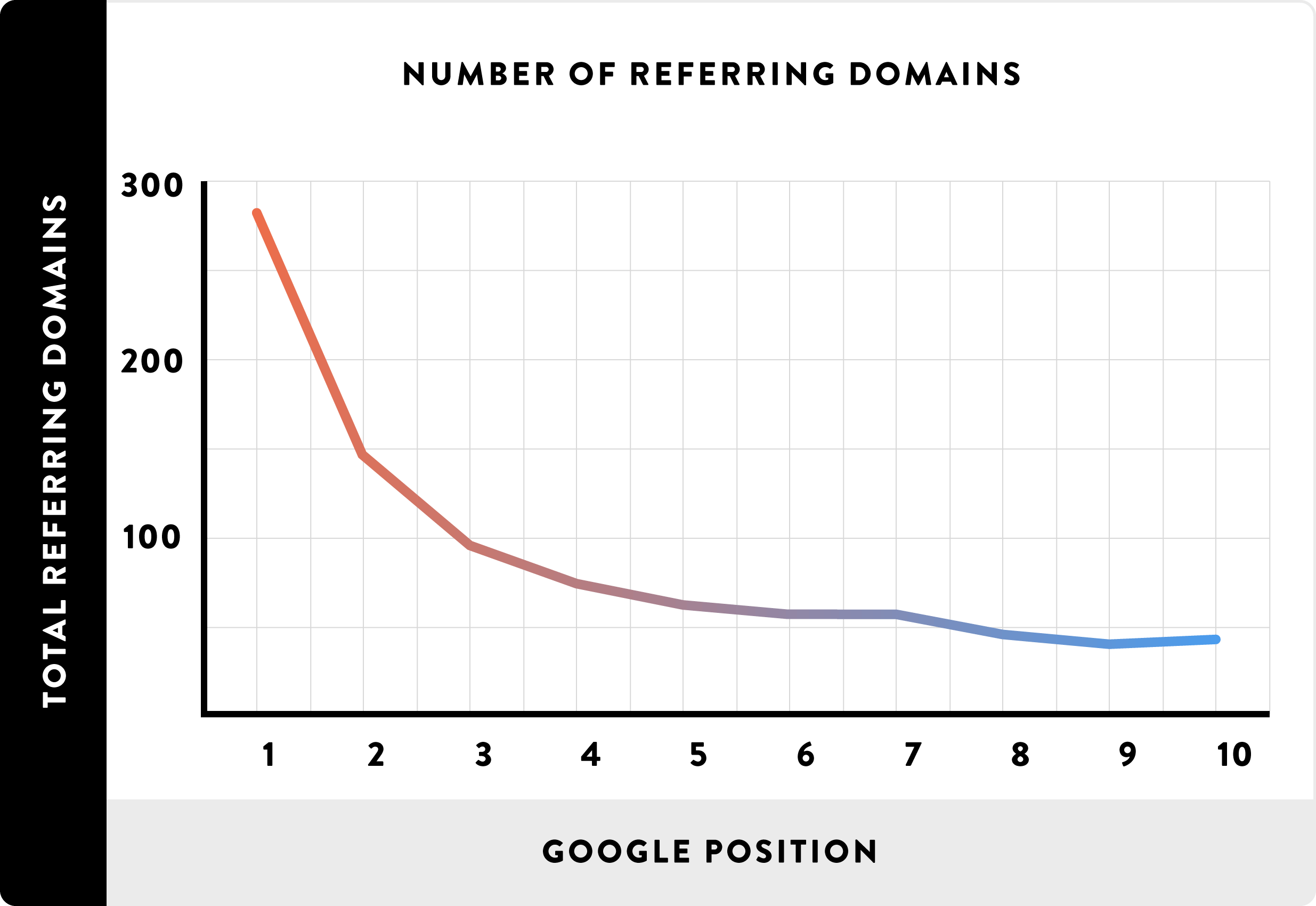
Google has also published a Search Quality Evaluation guidelines PDF if you have a few spare moments (read: days) to give it a look.
As you can see, it takes a long time for most of us to rank high in Google.
If you’ve blogged long enough, you’re probably aware of the ways that bloggers try to trick Google into putting their sites higher up in search results, quick.
In fact, you may have tried a few of these yourself.
How bloggers game the system
There are several ways that bloggers try to “game the system”. It’s not necessarily cheating, but it’s definitely pushing the limits of what Google had intended for how their ranking system works. When Google catches this, they penalize sites.
Bloggers game the system in several ways:
- Many companies and bloggers will buy links on high-DA websites. Backlinks are a big ranking signal for Google and the more backlinks that Google sees, the better the chances of ranking high. Companies sometimes pay big money for backlinks; in fact, you may have been asked a few times to include a backlink to another site.
- Some bloggers setup “link network” agreements with other bloggers. The idea is for a group of websites to work together by linking to one another. In theory, this helps all blogs within the group by boosting the number of backlinks that Google sees. Though, Google has been known to catch this type of behavior.
- Link sharing communities are similar to link networks but are often set up more like a paid service. These services charge a fee to share your content on social media, which can help with engagement and build so-called “social signals”. Though, it remains unclear if Google actually takes social signals into account in search results.
- And, Google penalizes sites that steal and duplicate content, “stuff” keywords into posts in an unnatural way, display too many ads or “hide” text in an attempt to make Google think there are more keywords.
There are scores of ways that bloggers and companies game the system, and Google’s clearly gotten wind of what’s happening (in fact, they have for some time). Google’s response is to reduce the technical components of their ranking signals and instead rely more heavily on truth and honesty through simple and organic markers on websites.
And, truth and honesty are difficult to fake. Here’s what it’s all about.

What is Google E-A-T?
As a part of the August 1st, 2018 algorithm update, Google began implementing a new (and improved) way of determining page authority, an uber-important metric that Google uses to compute search engine results.
The algorithm update hit so-called YMYL sites hard. Your Money or Your Life sites are websites that offer advice about potentially life-changing decisions, especially money, careers, and lifestyles. The impact of this type of advice is huge.
Naturally, Google wants to ensure it’s not recommending dangerous resources written by those who aren’t experts in their field, or those who don’t know what they’re talking about.
Google’s response is called E-A-T.
What does Google EAT stand for?
Google E-A-T stands for Expertise, Authoritativeness, Trustworthiness, and it’s Google’s new way of using honesty and transparency to rank search results. It’s another way of saying that Google is looking to rank expert writers more highly.
Does Google EAT replace everything I’ve done so far?
No, it doesn’t. Google has always stated that they want to see high-quality content. Long-form articles that add value by dissecting the topic thoroughly. Things that help your content rank higher include:
- Pages that load quickly
- Infographics that describe a process
- Headings that properly use keywords and phrases
- Links to high-quality external sources written by experts/leaders
All these things remain in effect. Backlinks are still important. Authority, though important before, remains just as important. But, the biggest difference with Google EAT is in how Google determines authority and authenticity.
How do I optimize my blog for Google EAT?
There are several new-ish techniques that Google looks for to evaluate the honesty and authenticity of your blog. Mainly, it wants to make sure that you’re honest, clear and know what you’re talking about. And, you aren’t afraid to cite other experts.
How does this happen? Find out below.
6 ways bloggers can exploit the Google EAT initiative
Google’s Expertise, Authoritativeness, Trustworthiness initiative isn’t difficult to understand or implement. Ultimately, it’s built on what Google considers to be high-quality content.
According to the guidelines document (linked above), high-quality content includes:
- High level of Expertise, Authoritativeness, and Trustworthiness (E-A-T).
- A satisfying amount of high-quality MC, including a descriptive or helpful title.
- Satisfying website information and/or information about who is responsible for the website. If the page is primarily for shopping or includes financial transactions, then it should have satisfying customer service information.
- Positive website reputation for a website that is responsible for the MC on the page. Positive reputation of the creator of the MC, if different from that of the website.
How can bloggers take full advantage of how Google ranks search results?
Action Step #1: Focus on insanely useful main content
“The quality of the MC (main content) is one of the most important criteria in Page Quality rating, and informs the E-A-T of the page,” the guidelines state. “Main content” is the body of the article. It’s the meat of the topic and this is where it all starts.
High-quality main content includes all the elements that we’ve talked about before on this blog. Things like writing effective copy for the web and a whole slew of blogging techniques used by the most successful bloggers, like being unique and marketing yourself well. And, adding value to the topic you’re writing about.
Writing high-quality main content takes quite a bit of time, effort and skill. It is factually accurate and honest. Also, it’s designed to be helpful, not just to sell a product or service (yes, most of the time Google can tell the difference!).
What makes content high-quality?
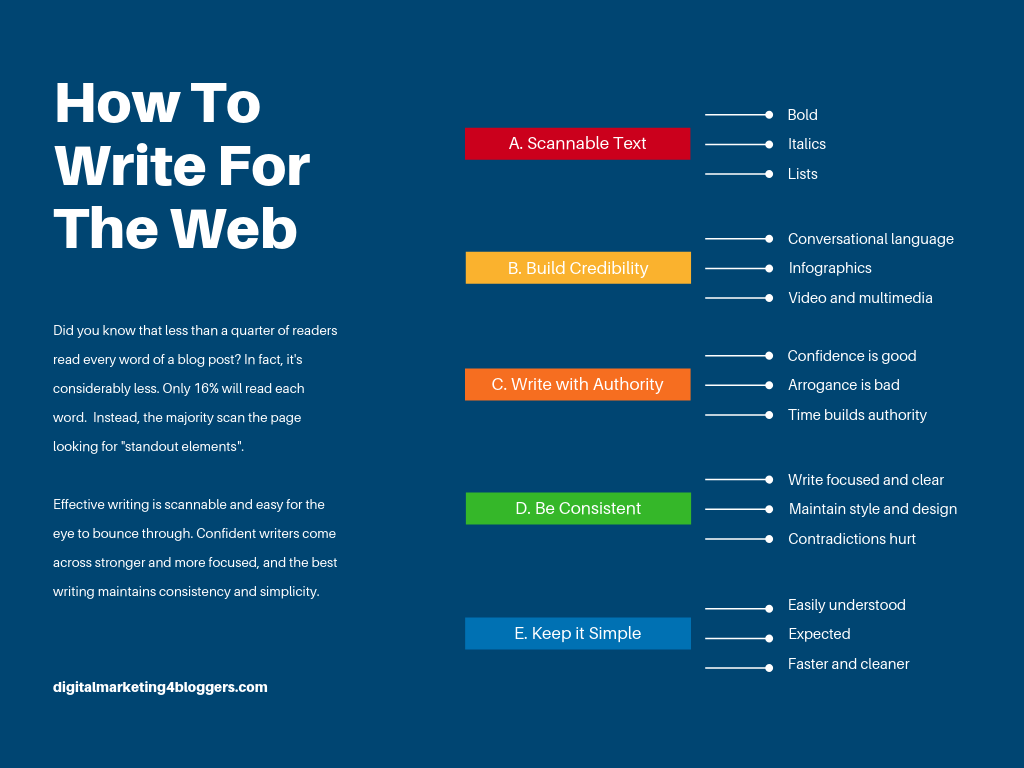
Before moving on to the subsequent steps, ensure that you’ve satisfied this one. Without high-quality main content, you greatly reduce the chances of ranking highly regardless of how well you implement the rest of these steps.
Start here, then move on.
Action Step #2: Write a highly informative ‘About’ page
A lot of bloggers don’t publish (or half-ass) an ‘About’ page because they don’t believe it’s crucial to their site. While that may have been true in the past, it’s a mistake to forget about your About page today. Why?
Your About page is one of Google’s key metrics in determining trustworthiness.
A blog’s About page should be your reader’s go-to source for everything about you. And, there are critical elements that should be included in your About page to maximize the trustworthiness factor:
- Your name and credentials
- Your physical address (if available)
- A contact method (email, form, etc)
- Your credentials (media mentions, presentations, awards, etc)
- A picture of you often helps, too, to make your About page more personal
If your blog represents a brand, then the same principles apply, though they may be tweaked a bit. Instead of YOUR name, it’ll be your brand’s name. Their mailing address. Maybe a picture of the storefront or a logo.
And, it may help to include major accolades or accomplishments of the brand.
One of my favorite About pages that I’ve seen is at Eight Hour Day:

It’s clear, direct and simple. Writing in plain English, it’s easy to understand. Their contact information is available without much searching. And, more information about their business and accolades are easily found.
Pro tip: Ensure that your About page accurately represents the topic of the blog. For example, a blogger shouldn’t tout his or her financial or career accomplishments on the About page of a graphic design blog – unless those accomplishments directly relate to graphic design.
Keep your About page focused and concise, but don’t neglect it. If you don’t have an About page, do three things right now:
- Create one and include as much detail as possible
- Ask a trusted friend or colleague to read it from the lens of a reader
- Link to the About page from within your navigation structure
By the way, here is the About page on this site.
Action Step #3: Include an author bio on every post
Google wants to see a high-quality bio associated with each and every post that you publish. Why? It’s one way to determine the trustworthiness of the content.
Including a bio means you aren’t trying to hide anything.
It also makes it easy for your reader to associate the main content with the direct accomplishments and expertise of the writer. Like with your About page, make sure the author’s bio is on-topic.
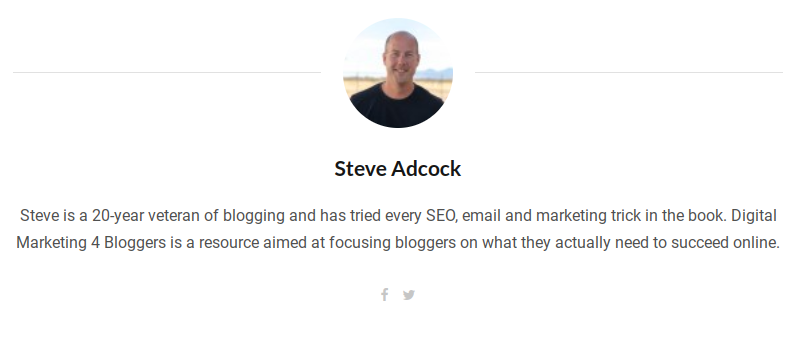
The bio should include essential elements like:
- Major accomplishments
- Awards, achievements and other accolades
- Why the author is an expert on the topic
- Associated social media profiles like Twitter, Facebook, etc
Author bios don’t need to be lengthy. In fact, short and sweet often work best. Keep all author bios direct and focused, no embellishments. Bio real estate is often tight on blogs, so make sure every word counts.
If you use WordPress, your theme might already support custom bios for every author. If it does, then you are good to go. All you need to do is create a bio.
Here’s how to create a custom bio using WordPress. From the admin console, hover your mouse over ‘Users’ on the left, then click ‘All Users’:

Next, select the user that you’d like to edit by clicking on the ‘edit’ link. On the next page, scroll down until you see the bio box. It’ll look something like this:

Include a helpful bio in the textbox, then click the blue ‘Update Profile’ button at the bottom of the page. If your theme supports custom author bios, it’ll likely be displayed at the bottom of the post.
If it doesn’t, there are a number of different plugins that can add this capability (or improve it if it’s already there). I like to use ‘Simple Author Box‘, but use the one that makes the most sense for your blog.
Here’s a quick example of searching for ‘author’ on the ‘Add New Plugin’ page:
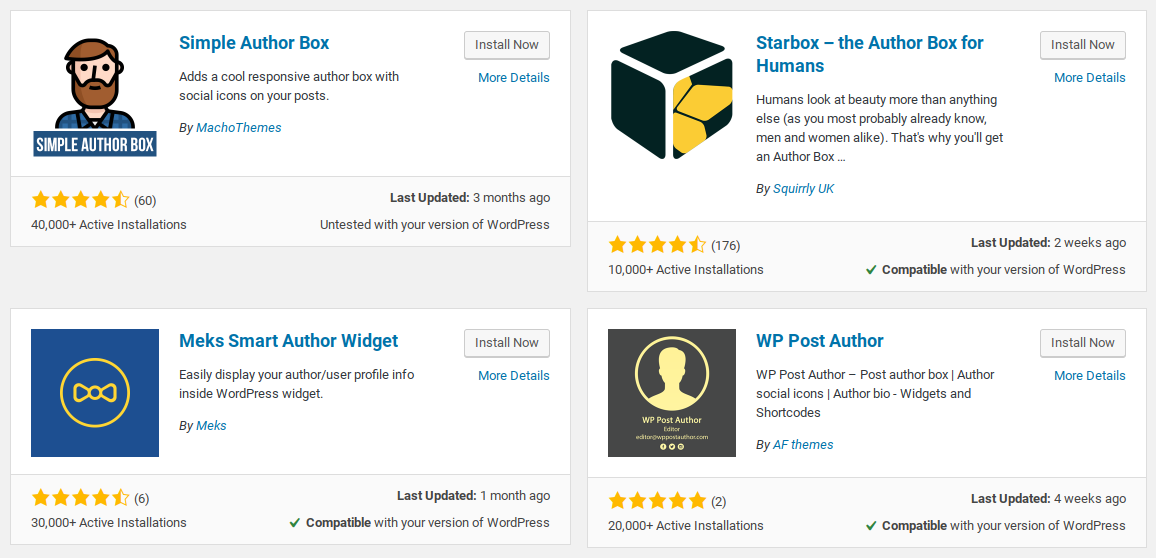
Action Step #4: Make your site as fast and secure as possible
Readers, just like Google, want fast websites. Nobody wants to sit for 10 seconds waiting for a page to load. It’s unprofessional and paints a picture that we probably don’t want to paint. First impressions count, especially on the Internet.
Readers will nearly always bail from slow or unprofessional websites.
Likewise, readers want to feel as if the site that they are on takes their privacy and security seriously. Browsers are making it increasingly obvious what sites are secure. As more and more sites transition over to HTTPS, you don’t want to be the odd one out.
Improve your site’s speed
One of the best tools to help analyze the speed of your site is Google Page Insights. The tool will run an analysis on your site and return an overall speed grade.
How fast is fast enough? Sem Rush says:

To run an analysis on your site, head over to Page Insights, type your URL into the box, then punch the ‘ANALYZE’ button on the right. It’ll take a few moments for the tool to run its analysis.
Then, you’ll get results that look something like this:
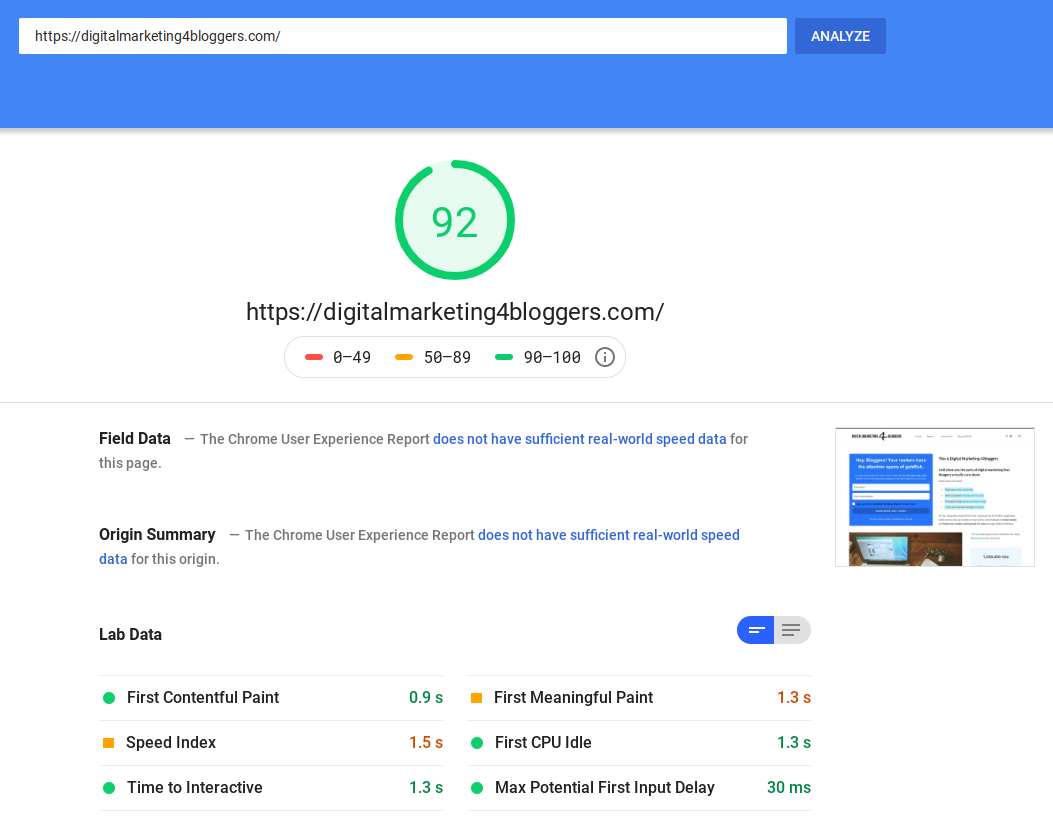
The results are divided up into two main platforms: Mobile and Desktop. Toggle between the two by using the two buttons on the top left:

If your site seems slow based on Google’s color ranking, there are any number of things that can be causing the problem. Many speed problems stem from too many Javascript or CSS files being loaded from external locations.
Using a caching system or CDN (Content Delivery Network) can help. Compressing your images in WordPress using something like Smush may also help.
Pro tip: Don’t go insane trying to increase your page’s speed. Yes, make it as fast as you can, but squeezing out every little bit of performance may not be necessary. Do what you feel is right to improve your site’s speed, then move on to other blogging tasks!
Using HTTPS on your blog
HTTPS is a communication protocol that encrypts all data that’s sent to and from HTTPS-enabled websites (like this one). When you request a page from an HTTPS site, the browser will first establish a “handshake” with the server. This establishes a secure mechanism to send and receive encrypted data.
All e-commerce sites that accept credit cards use HTTPS. And more and more, everyday blogs and most other sites are slowly transitioning over to HTTPS as well.
In fact, the trend toward HTTPS is pretty clear:
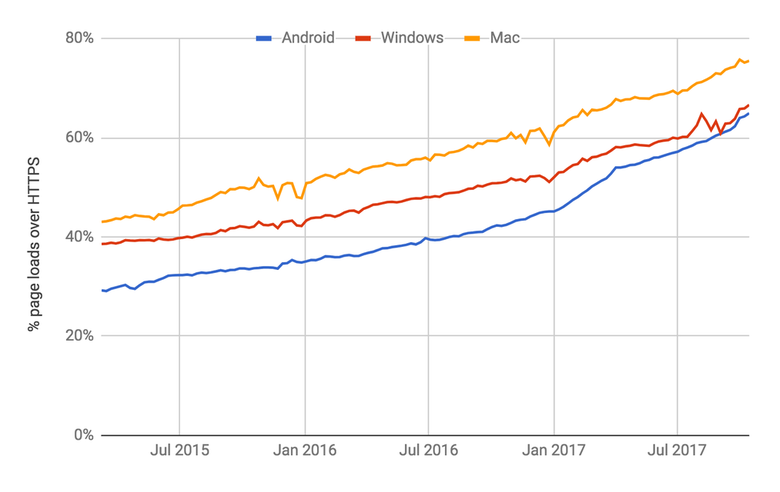
In the past, HTTPS used to be insanely difficult and expensive for most people. But today, it’s become nearly point-and-click.
If your web hosting provider supports a system called “Let’s Encrypt“, then you probably have access to a free and easy way to enable HTTPS. If you’re not sure, submit a trouble ticket and ask about what’s possible.
Google likes to see fast, secure websites. It helps improve your site’s authenticity.
Action Step #5: Remove or improve the content that doesn’t add value
We all write bad content.
It happens…to all of us. Especially early on in your blogging career, the things that we wrote probably wasn’t the best. Our writing may not have been as effective. We may not have used headings. Bold or italicized text.
Or, maybe the entire article just sucked. Yes, it happens.
Low-value content hurts your Google EAT score just like an underinflated tire reduces the stability of your car. It might still run, but it’s not optimal and you are risking a possible disaster. Bloggers need to address low-value content.
Use a tool like Google Webmaster Tools or Google Analytics to identify some of your low-performing pages. Then, decide whether to remove those pages or improve them with significant edits.
Note: The revise and republish content strategy is appropriate here.
Find low-value content using Google Webmaster Tools
If you aren’t sure how to use Google to find low-value pages, you’re in luck.
Here’s how.
1: Create or login to your account
If you don’t already have a Google Webmaster Tools (GWT) account, create one. It’s free and one of the best free tools that bloggers have at their disposal. It might take several days for data to begin appearing in your GWT account.
If you already have an account, login and visit your ‘Overview’ page. It will look something like this, though your numbers will be different. Notice that ‘Overview’ is selected on the left.

2: Access ‘Performance’ search results
To find your under-performing pages, click the ‘Search results’ link on the left that’s underneath the ‘Performance’ heading. The page will look like this:
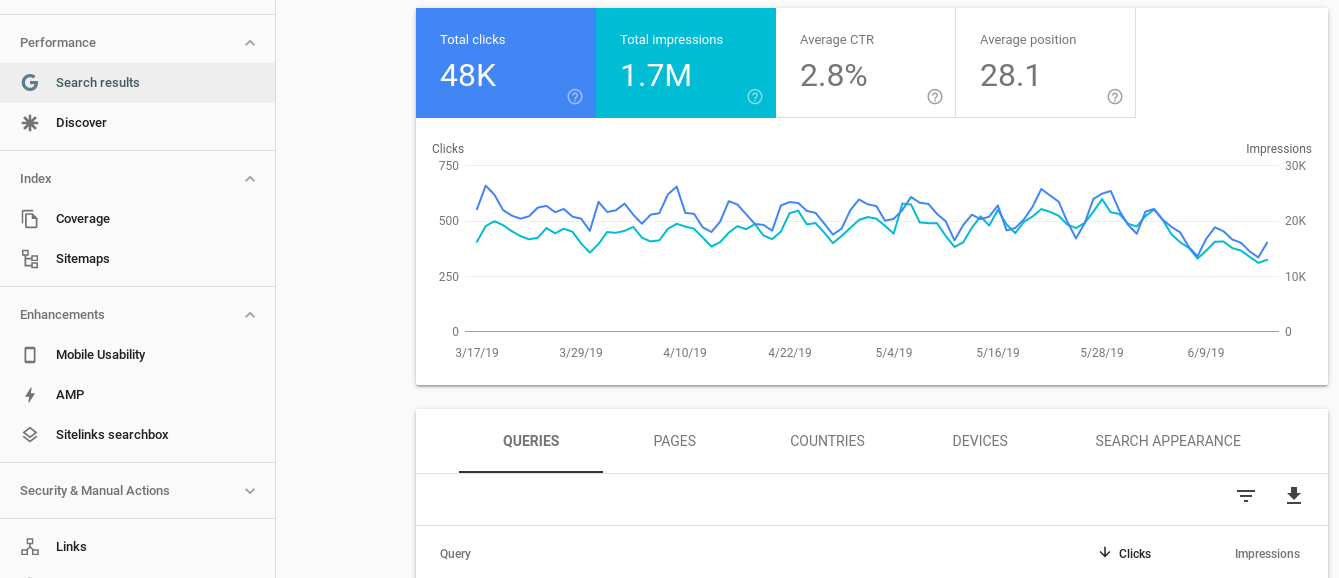
3: Sort pages by Impressions, descending
Finally, scroll down to the table of data. You will see filtering options like Queries, Pages, Countries, Devices and Search Appearance at the top.
Select Pages.

This will display a sorted table of all pages that Google has indexed from your site, generally sorted by the most clicks. By default, Google displays your pages by the most popular first.
However, we want the least popular pages.
The easiest way to re-sort the table is to select the ‘Impressions’ label on the right – twice. The first click will filter by Impressions (highest to lowest). The second click will reverse the sort to lowest to highest.

You’ll know that the table is sorted properly when the number of Impressions (as well as Clicks) is a small number. Now, you have a list of pages on your site that don’t get much Google love.
Sometimes, you’ll see your WordPress tag and category listing pages among the least popular. Generally, you don’t need to worry too much about these pages.
Instead, start paging through the list until you get to your blog posts.
Your blog posts are those pages that you probably want people to read and those are the pages that should demand the majority of your attention.
At this point, you have a choice to make:
- Delete low-value pages that don’t add to your blog, or
- Revamp them with major edits to improve their value
If you decide to remove them, don’t forget to set up a 301 redirect so the URL of the page doesn’t turn into a broken link. There are several plugins for WordPress that will do this for you. Usually, this process is pretty straightforward.
Or, you might choose to update the page instead.
When adding value to the page, pay special attention to the keyword that you’re using, the title of the page and the length of the main content. Sometimes, a complete re-write is necessary, but other times, small tweaks can result in some amazing changes. Don’t be afraid to update all the content if you need to.
Action Step #6: Link to experts
Don’t be afraid to link to experts on the topic that you are writing about. In fact, Google considers that to be a sign of authenticity from the author.
For example, I’ve linked to several high-quality resources in this article, including resources from Backlinko, Search Engine Journal, Ahrefs, Neil Patel and ZDnet. All of these resources are high value and help Google understand that my primary purpose with this blog post is to add value to the conversation.
And, experts add a ton of value.
Pro tip: Add at least one link to a high-DA site run by an expert in the topic.
Are you taking advantage of Google EAT?
That’s it! Google EAT is a genius endeavor by Google to help improve how the search engine determines expertise, authenticity as well as trustworthiness. It’s designed to boost websites that focus on well-researched, expert-level content.
And best of all, it helps decrease the likelihood that clever bloggers and website owners can trick Google through link sharing agreements and buying backlinks on valuable websites.
Have you started making changes to improve your Google EAT score? If so, what are you doing to encourage Google to “EAT up” your blog?





17 Comments
Thanks, you’ve finally motivated me to add an author bio on every post! That plugin is excellent, and it was surprisingly easy. Hopefully this will help with Google rankings.
You’re very welcome, Ingrid!
Garmin express – Garmin express is a software application designed by the company to update, install and manage all the garmin devices from your desktop only.
garmin express
Garmin Connect Login could even be a globally acknowledged location technology specialist that has revolutionized the navigation sector.
HP Printer Offline means your printer isn’t communicating with the pc . it’s the foremost common problem that arises when there’s low connectivity between the pc and thus the printer. Many of the HP Printer users encounter this error which they invite technical support. There are some causes thanks to which the matter arises. Below are the causes and its solutions.
Avast Account is a portal that is designed for managing your paid subscription, download Avast products, get details about your subscription and a lot more. Hence, account creation and Avast Sign In is an important process for enhancing your experience. For this, you have to follow the processes mentioned below.
Roadrunner Login Account Creation .
BullGuard Internet Security is an extraordinary cybersecurity programming that offers bleeding edge insurance for all your associated gadgets. This all encompassing work area application gives you tenacious security for Windows, Mac and Android gadgets.
Manual Setup Of Your Netgear Extender via Mywifiext .
Manual Setup Of Your Netgear Extender via Mywifiext ….
First and foremost, you should open your preferred internet browser on your computer. You may have Internet Explorer, Google Chrome, Firefox, Safari, etc. Hence, you have to open any of these browsers available on your computer.
AOL Mail includes a variety of services i.e. AOL mail, AOL Instant Messenger, AOL Video, video search, news, sports, weather, etc. With the help of AOL Mail, you can connect to the millions of people across the world.
Norton is an antivirus software that protects your devices against viruses, malware, spyware, and other online attacks. It helps you in avoiding unsafe websites by giving you regular alerts.
Avast is a complete cybersecurity software that provides protection against all the existing, emerging and advanced cyber threats. Online threat protection products by Avast are packed with cutting-edge features
TurboTax is an American tax software programming. It controls the client’s bit by bit in preparing and documenting their expense forms. This product helps in keeping the records of the earlier year’s assessment forms. Thus, you can utilize different highlights of Turbotax subsequent to finishing the procedure of Turbotax sign in.
How might it be in the event that you could get to news, email, LIVE games refreshes and can even sign-in your computer by means of simply entering one secret phrase? Truly, it is conceivable in the event that you pursue a Microsoft account by visiting office.com/myaccount.
Complete the Kaspersky sign in procedure to manage the kaspersky subscription, view the information and statistics of traffic usage